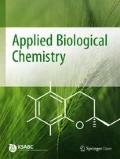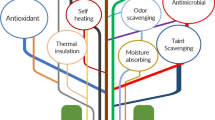Abstract
The antimicrobial activities of the essential oil obtained from the aerial parts of Ruta graveolens and 2-isopropyl-5-methylphenol analogs were evaluated against six food-borne bacteria. The essential oil of R. graveolens aerial parts exhibited potent antimicrobial activity against six food-borne bacteria. 2-Isopropyl-5-methylphenol was isolated by chromatographic analyses. The structure-activity relationships of the 2-isopropyl-5-methylphenol analogs, 2-isopropyl-5-methylphenol, and its structural analogs (2-isopropylphenol, 2-methylphenol, phenol, and 2-isopropyl-5-methylbenzene) were determined against six food-borne bacteria. When employing the agar diffusion method, 2-isopropyl-5-methylphenol and 2-isopropylphenol had potent antimicrobial activities against the six food-borne bacteria. The minimum bactericidal concentration (MBC) and minimum inhibitory concentration (MIC) values of 2-isopropyl-5-methylphenol and its structural analogs were determined against the six food-borne bacteria. 2-Isopropyl-5-methylphenol exhibited the strongest activity (MIC, 5–6.25 μg/mL; MBC, 6.25–12.5 μg/mL) against the six food-borne bacteria. Therefore, the essential oil of R. graveolens and 2-isopropyl-5-methylphenol analogs should be useful as natural food preservatives.
Similar content being viewed by others
References
Alzoreky NS and Nakahara K (2003) Antibacterial activity of extracts from some edible plants commonly consumed in Asia. Int J Food Microbiol 80, 223–30.
Burt FF and Foegeding PM (2003) Antibacterial activity of selected plant essential oils against Escherichia coli O157:H7. Lett Appl Microbiol 36, 162–7.
Dorman HJD and Deans SG (2000) Antimicrobial agents from plants: antibacterial activity of plant volatile. J Appl Microbiol 88, 308–16.
Ezoubeiri A, Gadhi CA, Fdil N, Benharref A, Jana M, and Vanhaelen M (2005) Isolation and antimicrobial activity of two phenolic compounds from Pulicaria odora L. J Ethnopharmacol 99, 287–92.
Farag RS, Daw ZY, Hewedi FM, and El-Baroty GSA (1989) Antimicrobial activity of some Egyptian spice essential oils. J Food Prot 52, 665–7.
Friedman M, Henika PR, and Mandrell RE (2002) Bactericidal activities of plant essential oils and some of their isolated constituents against Campylobacter jejuni, Escherichia coli, Listeria monocytogenes, and salmonella enterica. J. Food Prot 65, 1545–60.
Gallucci MN, Oliva M, Casero C, Dambolena J, Luna A, Zygadlo J et al. (2009) Antimicrobial combined action of terpenes against the food-borne microorganisms Escherichia coli, Staphylococcus aureus and Bacillus cereus. Flavour Fragr J 24, 348–54.
Helander IM, Alakomi HL, Latva-Kala K, Mattila-Sandholm T, Pol I, Smid EJ et al. (1998) Characterization of the action of selected essential oil components on gram-negative bacteria. J Agric Food Chem 46, 3590–5.
Ilkay YO, Ismail Y, Esin AS, and Nejat U (2004) Synthesis and structure-activity relationships of new antimicrobial active multisubstituted benzazole derivatives. Eur J Med Chem 39, 291–8.
Ivanova A, Mikhova B, Najdenski H, Tsvetkova I, and Kostova I (2005) Antimicrobial and cytotoxic activity of Ruta graveolens. Fitoterapia 76, 344–7.
Jeong EY, Lim JH, Kim HG, and Lee HS (2008) Acaricidal activity of Thymus vulgaris oil and its main components against Tyrophagus putrescentiae, a stored food mite. J Food Protec 71, 351–5.
Juven BJ, Kamnner J, Schved F, and Weissiowicz H (1994) Factors that interact with the antibacterial action of thyme essential oil and its active constituents. J Appl Bacteriol 76, 626–31.
Katayama T and Nagai I (1960) Chemical significance of the volatile components of spices in the food preservative view point. VI. Structure and antibacterial activity of terpenes. Bull Japan Soc Sci Fisheries 26, 29–32.
Kim MK, Choi GJ, and Lee HS (2003) Fungicidal property of Curcuma longa L. rhizome-derived curcumin against phytopathogenic fungi in a greenhouse. J Agric Food Chem 51, 1578–81.
Kim YM, Lee CH, Kim HG, and Lee HS (2004) Anthraquinones isolated from Cassia tora (Leguminosae) seed show an antifungal property against phytopathogenic fungi. J Agric Food Chem 52, 6096–100.
Lambert RJW, Skandamis PN, Coote PJ, and Nychas GJE (2001) A study of the minimum inhibitory concentration and mode of action of Oregano essential oil, thymol and carvacrol. J Appl Microbiol 91, 453–62.
Lee HS (2002) Tyrosinase inhibitors of Pulsatilla cernua root-derived materials. J Agric Food Chem 50, 1400–03.
Lee HS and Ahn YJ (1998) Growth-inhibiting effects of Cinnamomum cassia bark-derived materials on human intestinal bacteria. J Agric Food Chem 46, 8–12.
Lim MY, Jeon JH, Jeong EY, Lee CH, and Lee HS (2007) Antimicrobial activity of 5-hydroxy-1,4-naphthoquinone isolated from Caesalpinia sappan toward intestinal bacteria. Food Chem 100, 1254–8.
Liolios CC, Gortzi O, Lalas S, Tsaknis J, and Chinou I (2009) Liposomal incorporation of carvacrol and thymol isolated from the essential oil of Origanum dictamnus L. and in vitro antimicrobial activity Food Chem 112, 77–83.
Lopez P, Sanchez C, Batlle R, and Nerin C (2007) Vapor-phase activities of cinnamon, thyme, and oregano essential oils and key constituents against foodborne microorganisms. J Agric Food Chem 55, 4348–56.
Malik AA, Mir SR, and Ahmad J (2013) Ruta graveolens L. essential oil composition under different nutritional treatments. Am-Eurans J Agric & Environ Sci 13, 1390–5.
NCCLS (2003) Methods for dilution antimicrobial susceptibility testing. 9th International Supplement (M100-59). National committee for Clinical Laboratory Standards. USA.
Nikaido H (1994) Prevention of drug access to bacterial targets: permeability barriers and active efflux. Science 264, 382–8.
Oribe Y and Miyazzaki Y (1997) Effects of two weed oils on the population growth of the European house-dust mites, dermatophagoides pteronyssinus. Mokuzai Gakkaishi 43, 521–3.
Oussalah M, Caillet S, Saucier L, and Lacroix M (2007) Inhibitory effects of selected plant essential oils on the growth of four pathogenic bacteria: E. coli O157:H7, Salmonella Typhimurium, Stapylococcus aureus and Listeria monocytogenes. Food Control 18, 414–20.
Prabuseenivasan S, Jayakumr M, and Ignacimuthu S (2006) In vitro antibacterial activity of some plant essential oils. BMC Complem Altern M 6, 39.
Santiesteban-Lopez A, Palou E, and Lopez-Malo A (2007) Susceptibility of food-borne bacteria to binary combinations of antimicrobials at selected a w and pH. J Appl Microbiol 102, 486–97.
Soleimani M, Azar PA, Saber-Tehranil M, and Rustaiyan A (2009) Volatile composition of Ruta graveolens L. of north of Iran. Word Appl Sci J 7, 124–6.
Vincenzo DF, Francesco DS, and Felice S (2002) Potential allelochemicals from the essential oil of Ruta graveolens. Phytochemistry 61, 573–8.
Walsh C (2000) Molecular mechanisms that confer antibacterial drug resistance. Nature 406, 775–81.
Yang JY and Lee HS (2013) Changes in acaricidal potency by introducing functional radicals and an acaricidal constituent isolated from Schizonepeta tenuifolia. J Agric Food Chem 61, 11511–6.
Yang JY, Park JH, and Lee HS (2013) Isolation of 8-hydroxyquinoline from Sebastiania corniculata and antimicrobial activity against food borne bacteria. J Korean Soc Appl Biol Chem 56, 763–6.
Yang YC, Lee SG, Lee HK, Kim MK, Lee SH, and Lee HS (2002) A piperidine amide extracted from Piper longum L. fruit shows activity against Aedes aegypti mosquito larvae. J Agric Food Chem 50, 3765–7.
Author information
Authors and Affiliations
Corresponding authors
Rights and permissions
About this article
Cite this article
Jeon, JH., Park, JH. & Lee, HS. 2-isopropyl-5-methylphenol isolated from Ruta graveolens and its structural analogs show antibacterial activity against food-borne bacteria. J Korean Soc Appl Biol Chem 57, 485–490 (2014). https://doi.org/10.1007/s13765-014-4136-7
Received:
Accepted:
Published:
Issue Date:
DOI: https://doi.org/10.1007/s13765-014-4136-7



